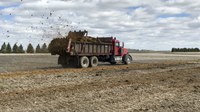Noxious, Troublesome Weeds Spread Through Manure
(Click the image below to view a high-resolution image that can be downloaded)
Using manure as fertilizer can lead to the spread of noxious and troublesome weeds.
“It is a known fact that weed seeds pass unharmed through the digestive tracts of ruminant animals (cattle, sheep),” says Mary Keena, livestock environmental management specialist based at North Dakota State University’s Carrington Research Extension Center. “This means that whatever weed seeds are in the feed or bedding you’re using are still viable when they exit the animal as manure.
“There is also a line of thought that says there is an extensive weed seed bank in most fields already and applying manure gives them the nutrients they need to grow,” she adds. “Either way, manure does promote plant growth.”
Producers have tools to minimize the amount of viable weed seeds in fresh manure, one of which is composting. Information about composting is available in a self-paced online workshop at https://tinyurl.com/2020CompostingWorkshop. To learn the reasons behind these composting operations, check out https://tinyurl.com/2020CompostProducerOperations.
Another tool more commonly used is herbicide control. Applying a pre-emergence herbicide will help reduce competition between weeds and newly seeded crops.
But what happens when those herbicides don’t work on specific noxious and troublesome weeds? How do you keep noxious and troublesome weeds at bay when you need to spread manure but know hard-to-control seeds such as Palmer amaranth and waterhemp are present?
“Even in direct competition with a crop, these plants can still produce up to 100,000 seeds in a year,” warns Joe Ikley, NDSU Extension weed specialist.
Due to this extensive seed production, the ability of the weeds to germinate throughout the growing season, and widespread resistance to glyphosate and Group 2 herbicides, herbicide programs for control of severe infestations of waterhemp and Palmer amaranth often will cost two to three times the amount of money spent on a weed control program in fields without these two weeds, he says.
In addition to the added cost of controlling these weeds, weed scientists in the U.S. have documented herbicide resistance in Palmer amaranth to every herbicide mode of action that can be used in row crop production.
“This is why it is important to scout fields for these two pigweeds before they become established,” Ikley says. “In many cases where the weeds are spread in contaminated manure, the infestation starts with a manageable level of plants and the population can be managed by hand pulling if correctly identified.”
Producers have a few steps they can take to help mitigate and monitor the potential impacts of these weeds. One is to keep records of where they spread manure so they can monitor that field throughout the growing season.
Another step is to clean spreading equipment before moving to a new field.
“This is probably one of the most important and least popular steps you can take,” Keena says. “If you are doing custom work for someone, this is especially important as you do not want to take one client’s issue to the next client.
“Clean the spreader with an air hose for dry manure or a pressure washer for wet manure,” she advises. “This takes time and can be messy but can save years of headaches down the road. Make sure to record where cleanout occurs so you can monitor that spot during the growing season.”
She recommends spreading weed seed-heavy manure on tame grass pastures or grass hayfields because more options are available for herbicide control on them.
“It is never recommended to spread manure on native rangeland,” says Miranda Meehan, NDSU Extension livestock environmental stewardship specialist. “Adding additional nutrients can benefit invasive grass species such as Kentucky bluegrass and smooth brome.”
For more information about noxious and troublesome weeds or manure management, contact the NDSU Extension agent in your county. Visit https://www.ag.ndsu.edu/extension/directory to find the Extension office in your county.
NDSU Agriculture Communication - March 25, 2021
Source: Mary Keena, 701-652-2951, mary.keena@ndsu.edu
Source: Miranda Meehan, 701-231-7683, miranda.meehan@ndsu.edu
Source: Joe Ikley, 701-231-8157, joseph.ikley@ndsu.edu
Editor: Ellen Crawford, 701-231-5391, ellen.crawford@ndsu.edu


